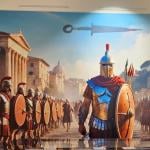Isaiah 11:9: They shall not hurt nor destroy in all My holy mountain, for the earth shall be full of the knowledge of the LORD as the waters cover the sea.
This well-known passage is part of Isaiah’s great prophecy about the Spirit-filled Branch from the stem of Jesse, the Davidic King who is coming to judge the earth, and to bring peace and righteousness. Just before this verse, Isaiah has envisioned a world where wolfs and lambs, leopards and goats, calves and lions lie down side by side in peace, and a little child will lead them.
Every baptism depicts the fulfillment of Isaiah’s prophecy. Every baptism extends the knowledge of the Lord to another bit of earth, another human being made of dust. Every baptism showed the knowledge of the Lord spread out like the waters of the sea.
But Nesradine’s baptism depicts the fulfillment of this promise in an especially dramatic way, because the water of today’s baptism embraces the globe. We declare God’s baptismal promise here in Northern Idaho , but we declare that promise to a child who was born on the opposite side of the world.
In this case, it is we, and not Nesradine and his nation, who are latecomers to the gospel. The ancient kingdom of Ethiopia , known as Aksum , was one of the first kingdoms to covert to Christianity. Ethiopia had been Christian more than a millennium before Europeans began to settle on this continent. So this baptism not only demonstrates that God’s promises are catholic, universal, extending to the four corners of the earth; but it also demonstrates God’s faithfulness through time. God showed to the Ethiopians of the fourth century, and He is still pouring out that mercy in the 21 st .
Isaiah gives us a stirring vision of what the new covenant, and what baptism as a sign of the new covenant, are all about. But we don’t get the depths of this passage unless we recognize the unease that is underlying the image; we miss part of the meaning of the passage if we don’t hear the dissonant chords within Isaiah’s song of triumph.
Isaiah does not say that the sea will cover the earth, but he does say that the knowledge of Yahweh is like the waters of the sea, and that this deluge of the knowledge of the Lord will engulf the earth. That is disquieting, because from the beginning of creation the waters have symbolized the great threat to the land, a great threat to human life.
At the beginning, the Lord sets bounds to the sea, dividing it from the land, but the waters can break the boundary. The image of waters overwhelming the land is a fearful one. It conjures up the flood, which wiped away the world that then was. It conjures up the exodus; Israel passed over on dry land, but when Pharaoh tried to follow, that strip of dry land was covered by the sea. When the prophets spoke of the invasion of Gentiles into the holy land of Israel , they described it as a flood of nations surging over the land and covering it.
The sea is usually a threatening image of judgment, yet, here is Isaiah, using the image of the sea to depict the promise of the new covenant, the promise of peace and knowledge of God.
These two uses of the sea image are not in conflict, but point to the way that the Lord has chosen to renew His covenant and fulfill His plan for creation. He has chosen to remake the world through judgment and renewal, through death and resurrection. As in the flood, He has chosen to restore the creation by sending a cleansing flood.
All that is what is being declared here to Nesradine, and to you his parents. Through this sprinkling of water, Nesradine is being joined to the death and resurrection of Jesus, being buried with Christ so that he can be raised to walk in newness of life. Through this sprinkling of water, God is enacting His promise to fill the earth with the knowledge of the Lord as waters cover the sea.











